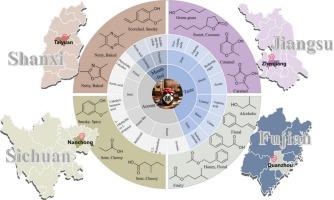在分子水平上揭示中国四大传统食醋的感官差异
IF 9.8
1区 农林科学
Q1 CHEMISTRY, APPLIED
引用次数: 0
摘要
醋作为一种传统的发酵调味品,在中国饮食文化中占有举足轻重的地位。采用风味组学方法,对山西陈醋(SAV)、四川宝宁醋(SBV)、福建红曲霉醋(FMV)和镇江芳香醋(ZAV)的感官差异和特征化学成分进行了分析。虽然整体感官特征相似,但在酸味、谷物味、水果味、酒精味和酸味方面存在显著差异。此外,这些醋分别含有3、3、5和4种关键香气化合物,这些香气化合物显著区分了每种醋。此外,乙酸、乙酰乙醇、苯乙醇和2-甲基丙烷酸是主要的香气差异标志物。此外,还原糖、非挥发性酸、无盐可溶性固体和氨基酸共同影响味道和口感。进一步分析表明,Glu、His、Ala和Val是4种食醋的主要风味化合物,且它们之间存在显著差异。为食醋行业的质量提升和创新提供了理论依据。本文章由计算机程序翻译,如有差异,请以英文原文为准。

Unraveling sensory differences among the four famous traditional Chinese vinegars at the molecular level
As a traditional fermented condiment, vinegar holds a pivotal position in Chinese food culture. In this work, the sensory differences and characteristic chemical compositions of Shanxi aged vinegar (SAV), Sichuan Baoning vinegar (SBV), Fujian Monascus vinegar (FMV) and Zhenjiang aromatic vinegar (ZAV) were analyzed through flavoromics. While overall sensory characteristics were similar, significant differences were identified in sour, grain-like, fruity, alcoholic aroma and sour taste. Furthermore, these vinegars contained 3, 3, 5 and 4 key aroma compounds, respectively, that significantly differentiated each vinegar from the others. Additionally, acetic acid, acetoin, phenethyl alcohol and 2-methylpropanoic acid were determined to be the key aroma difference markers. Moreover, reducing sugars, non-volatile acids, salt-free soluble solids and amino acids collectively influenced the taste and mouthfeel. Further analysis demonstrated that Glu, His, Ala and Val were identified as key taste compounds in all 4 vinegars, and significant differences were observed among them. This work provides a theoretical basis for quality enhancement and innovation in the vinegar industry.
求助全文
通过发布文献求助,成功后即可免费获取论文全文。
去求助
来源期刊

Food Chemistry
工程技术-食品科技
CiteScore
16.30
自引率
10.20%
发文量
3130
审稿时长
122 days
期刊介绍:
Food Chemistry publishes original research papers dealing with the advancement of the chemistry and biochemistry of foods or the analytical methods/ approach used. All papers should focus on the novelty of the research carried out.
 求助内容:
求助内容: 应助结果提醒方式:
应助结果提醒方式:


